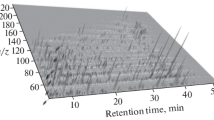Abstract
Analysis of soil gases is a relatively rapid and inexpensive method to delineate and measure hydrocarbon contamination in the subsurface caused by diesel or gasoline. Techniques originally developed for petroleum exploration have been adapted to tracking hydrocarbons which have leaked or spilled at or below the earth's surface.
Discriminant analysis (a multivariate statistical technique) is used to classify soil gas samples of C1 to C7 hydrocarbons as biogenic (natural soil gases) or thermogenic (contaminant hydrocarbons). Map plots of C1 to C7 total interstitial hydrocarbons, C2 to C7 interstitial hydrocarbons, and C1/ΣC n rations are used to further delineate and document the extent and migration of contamination.
Three case studies of the technique are presented: each involves leakage of hydrocarbons from underground storage tanks. Soil gas analysis clearly defines the spread of contamination and can serve as the basis for the correct placement of monitoring wells. The method proved to be accurate, rapid, and cost-effective; it therefore has potential for widespread application to the identification of soil and groundwater contaminated by hydrocarbons.
Similar content being viewed by others
References
Albertsen, M. and Matthess, G.: 1978, ‘Ground Air Measurements as a Tool for Mapping and Evaluating Organic Groundwater Pollution Zones’, International Symposium on Ground Water Pollution by Hydrocarbons: 235–251.
DillonW. R. and GoldsteinM.: 1984, Multivariate Analysis Methods and Applications, New York, John Wiley and Sons.
HorvitzL.: 1939. ‘On Geochemical Prospecting’, Geophysics 4, 210–225.
HorvitzL.: 1972, ‘Vegetation and Geochemical Prospecting for Petroleum’, Am. Assoc. Pet. Geol. Bull. 56, 925–940.
HorvitzL.: 1985, ‘Geochemical Exploration for Petroleum’, Science 229, 821–827.
HuntJ. M., MillerR. S., and WhelanJ. K.: 1980, Formation of C4−C7 Hydrocarbons from Bacterial Degradation of Naturally Occurring Terpenoids, Nature 288, 577–588.
LappalaE. and ThompsonG. M.: 1984, ‘Detection of Groundwater Contamination by Shallow Soil Gas Sampling in the Vadose Zone: Theory and Applications’, in Proceedings of the 5th National Conference on Management of Uncontrolled Hazardous Waste Sites. Hazardous Materials Control Research Institute. Silver Springs, MD, pp. 20–28.
LaubmeyerG.: 1983, ‘A New Geophysical Prospecting method, Specially for Deposits of Hydrocarbons’, Petroleum 29, 1–4.
Marrin, D. L. and Thompson, G. M.: 1984, ‘Remote Detection of Volatile Organic Contaminants in Groundwater via Shallow Soil Gas Sampling’, in Proceedings of the Petroleum Hydrocarbons and Organic Chemicals in Groundwater Conference. Houston, Texas. National Water Well Association, pp. 21–27.
MarrinD. L.: 1985, ‘Delineation of Gasoline Hydrocarbons in Groundwater by Soil Gas Analysis’, in Proceedings of the 1985 HazMat West Conference, Long Beach, California. Tower Conference Management Company, Wheaton Ilinois, pp. 112–119.
MarrinD. L. and ThompsonG. M.: 1987, ‘Gaseous Behavior of TCE Overlying a Contaminated Aquifer’, Ground Water 25, 1.
NieN. H., HullC. H., JenkinsJ. G., SteinbrennerK., and BentD. H.: 1975, Statistical Package for the Social Sciences, (2nd. ed.), New York, McGraw-Hill.
RosaireE. E.: 1940, ‘Geochemical Prospecting for Petroleum’, Am. Assoc. Pet. Geol. Bull. 24, 1401–1433.
SaenzG.: 1984, ‘Geochemical Prospecting in Mexico’, Org. Geochemistry 6, 715–726.
Saenz, G.: 1987, ‘Geochemical Exploration for Petroleum in a Marshy Area: Examination and Statistical Analysis of C1−C7 Hydrocarbons in near Surface Samples’, Master's thesis, University of Texas at El Paso, EL Paso, Texas. 130 p.
SaenzG. and PingitoreN.: 1989, ‘Organic Geochemical Prospecting for Hydrocarbons: Multivariate Analysis, Jour. Geochemical Exploration 34, 337–349.
SaenzG., FuentesH. R., and PingitoreN. E.: 1989, ‘A Discriminating Method of the Identification of Soils and Groundwater Contaminated by Hydrocarbons’, Proceeding of Petroleum Hydrocarbons and Organic Chemicals in Ground Water: Prevention, Detection and Restoration, NWWA. 2, 915–929.
SchoellM.: 1983, ‘Genetic Characterization of Natural Gases’, Am. Assoc. Pet. Geol. Bull. 67, 2225–2238.
SiegelF. R.: 1974, ‘Geochemical Prospecting for Hydrocarbons’, in Applied Geochemistry. Wiley-Interscience, New York, pp. 228–252.
Silka, L. R.: 1988, ‘Simulation of Vapor Transport Through the Unsaturated Zone. Interpretation of Soil-Gas surveys’, GWMR Focus, pp. 115–123.
Sokolov, V. A.: 1933, ‘The Gas Survey as a Method of Prospecting for Oil and Gas Formation’, Technika. 1.
SpittlerT. M., FitchL. and CliffordS.: 1985, ‘A New Method for Detection of Organic Vapors in the Vadose Zone’, in Proceedings of the Characterization and Monitoring of the Vadose Zone Conference, Denver, Colorado, National Water Well Association, Dublin, OH.
StahlW.: 1973, ‘Carbon Isotope Ratios of German Natural Gases in Comparison with Isotope Data of Gaseous Hydrocarbons from Other parts of the World’, in B.Tissot and F.Bienner (eds.), Advances in Organic Geochemistry, Paris: Editions Technip, pp. 453–461.
Walter, E. G., Pitchford, A. M. and Olhoeft, G. R.: 1987, ‘A Strategy for Detecting Subsurface Organic Contaminants, in Proceedings of the National Waterwell Assoc. Conf. on Petroleum Hydrocarbons and Organic Chemical in Ground Water, Nov. 12–14, Houston, Texas.
Author information
Authors and Affiliations
Rights and permissions
About this article
Cite this article
Saenz, G., Pingitore, N.E. Characterization of hydrocarbon contaminated areas by multivariate statistical analysis: Case studies. Environ Monit Assess 17, 281–302 (1991). https://doi.org/10.1007/BF00399309
Issue Date:
DOI: https://doi.org/10.1007/BF00399309




